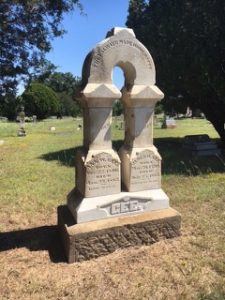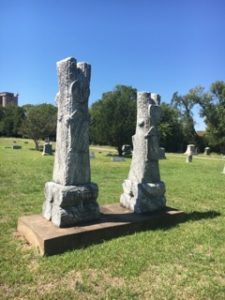
Tombstone of War of 1812 veteran James H. Gee and his wife Ann. Gee was the only veteran of that war buried in Greenville.
Let’s take a visit to East Mount Cemetery in Greenville this week. I must admit I have never walked the entire ten-plus acre cemetery myself, but I have visited many different gravesites over the years. The first marked graves date back to 1850, although it is entirely possible that earlier burials occurred. I suspect that maybe the earliest was in the mid-1840s. Several families lived in this vicinity well before the county was created with Greenville as county seat.
Those very early graves were marked with sandstone markers or wooden posts. Needless to say, neither material stands the test of time easily. Our blackland clay soil has not been kind to cemetery markers. It expands when wet and contracts during dry periods, creating a slowly moving base for tombstones. Right now the ground is dry. Many of the larger stones are tilting to one side or the other. Others have toppled completely or lost part of the tall stones. Earlier this fall I was out there and it was so sad to see the condition of the cemetery. But such is our environment.
There is some discussion about the first grave at East Mount. Historian W. Walworth Harrison believed it was the grave of Mary Shaw who died in childbirth in April 1850. Others suggest it was John W. Lane or George R. Moffitt, whose stone has this verse: “Go home dear friends and I will be here until Christ appears.” One of the early graves may be a child of attorney Hardin Hart, a staunch Unionist and District Judge appointed by the occupational forces after the Civil War.
The site was originally used for the first schoolhouse in Greenville. So before the Civil War it served as both cemetery and school. The earliest graves are at the top of the “hill”, the highest point around. At that time, the Jefferson Road ran from the town of Jefferson to Dallas. As it rounded the hill, it veered slightly to the north and then west to enter Greenville on what is today Washington Street.

Examples of Woodmen of the World grave markers at East Mount Cemetery. These were prevalent in the Midwest and South from 1890 through the Great Depression.
The graves exhibit many Masonic emblems, various sorts of Woodmen of the World markers, and beautiful artistry. The General Society of the War of 1812 has recently refurbished one stone, for James Hicks (J.H.) Gee and his wife Ann Hawkins Gee. Mr. Gee was a musician in Captain Bradford’s Company of Tennessee Militia when they marched to New Orleans in 1815 to fight the British under General Andrew Jackson. That makes him the only War of 1812 veteran buried at East Mount. While James was born in 1799, his mother-in-law, Margaret S. Hawkins was born in 1779. Her husband was J. H.’s brigade general Caleb Hawkins. The general didn’t make it to Texas but his wife did. If you are descended from James H. Gee, please let me know.
Now I must tell you my favorite or probably the most interesting grave at East Mount. It involves the death of John C. Wilson, a young lawyer here about 1858. It seems Wilson had earlier that year killed his brother-in-law Dr. James A. Coles with a double-barrel shotgun. Witnesses said it was self-defense. Shortly thereafter, Wilson was shot to death in the courtroom during a trial. I have never learned who pulled the trigger, but it sounds suspicious. To top it off, both men were married to sisters, daughters of James and Margaret Moody. Mrs. Moody definitely had a reputation for being somewhat of a wildcat!

This is very good reading. Thanks for the research. Re a Gee connection: James G Gee, pres of ETSTC was from Huntsville,
Tx. Have you had a tour of the campus , in a golf cart. with Mayor Wyman Williams directing it? I did last week and learned so much current and historical information. I highly recommend you try to do the same tour.
Really like your articles; never miss one !
Great history for Greenville…thanks for sharing!
Hardin Hart was my fourth or fifth great grandfather. My parents and two of my brothers are buried on his lot. The story I’ve heard all my life is Hardin had a big lot and allowed any pauper to be buried there on his lot if need be. We were also told if a grave was dug and bones were discovered, just move over and start digging again.The paupers didn’t have headstones….